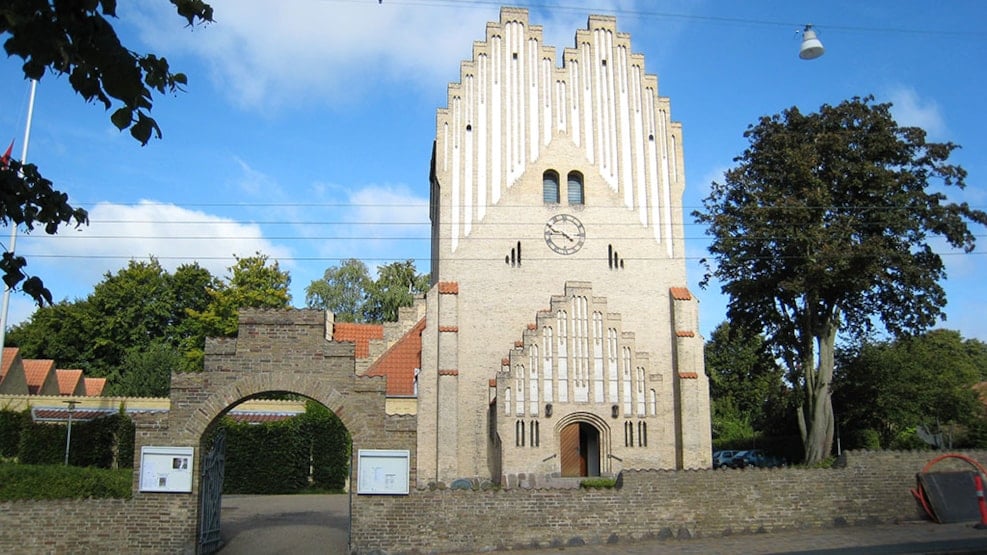
Fredens Kirke (Church) - Odense
At the intersection of Skibhusvej and Døckerslundvej stands Fredens Church. The church is, in many ways, a significant piece of Skibhus Quarter's history.
Skibhus Quarter's History
Back in the 17th century, Skibhusvej was established as a crucial link between Odense and the building known as Skibhuset, a warehouse for goods. This laid the foundation for a small village called Skibhusene, which emerged around the building and later evolved into the Skibhus Quarter. In 1764, a group of merchants began constructing properties along Skibhusvej, giving rise to the Sct. Hans Parish. The area was marked by contrasts, particularly evident on Bredstedgade, where one side boasted grand palaces and the other working-class neighborhoods.
With the development of the parish, a new issue arose - the distance between Sct. Hans Parish and Sct. Hans Church in Nørregade was too great for the churchgoers to easily reach.
The Church
In 1913, the parish council decided to build a new church, and after the location was determined, fundraising for the construction began. However, the church was not completed until 7 years later, partly due to financial constraints. The beginning of the 20th century was shaped by World War I and economic challenges, making it impressive that half of the costs for constructing Fredens Church were covered through donations.
The foundation stones for the church were laid in 1918, and on September 26, 1920, the church was consecrated by Bishop L.N. Baslev, on King Christian the Tenth's 50th birthday. The church received its name as a grateful tribute to the end of World War I.
Architecture
Fredens Church stands out from other Danish churches in several ways, most notably in its placement. While it's an ancient church tradition for the altar to face east, where the sun rises, and the resurrection is believed to take place, Fredens Church was designed with an entrance directly facing the street, causing the altar to face west.
The church was designed by architect P. V. Jensen Klint, who also designed the Grundtvig's Church in Copenhagen. The church bears features reminiscent of medieval churches, especially in its rustic woodwork and brickwork, used as artistic decoration, evoking associations with medieval architecture. However, Jensen Klint drew inspiration for the tall, pointed windows from Gothic cathedrals.
The church is constructed from handcrafted white-yellow stones and features a base of split fieldstones. The roof is covered in red clay tiles. The gables are respectively double and triple-layered stepped gables, designed with a slight curvature, and all surfaces are whitewashed. The churchyard is enclosed by a wall of light handcrafted stones and paved with red clay tiles. The area around the church was designed by landscape architect P. Wad.
Parish Hall with assembly hall, meeting rooms, and administrative office was added in 1981, designed by the well-known church architects Inge and Johannes Exner.
The Church Interior
As you enter the church, you will be greeted by Gothic arches spanning the nave and five large chandeliers, designed by Esben Klint, the grandchild of Jensen Klint. Behind the altar, there are three stained glass mosaics, and additional mosaics to the north and east, all created by the artist Johs. Kragh.
The altarpiece is carved from oak and sculpted by artist Alex Poulsen, also known for a memorial at Ryvangen in Copenhagen, a reunification monument in Copenhagen, and several altarpieces, including the one at Ansgar Church in Odense. The frame around the altarpiece is Jensen Klint's work.
Jensen Klint's influence on Fredens Church is evident, as he not only contributed to its exterior, but also designed the altar rail, pulpit, the seven-armed candelabrum by the baptismal font, and the panels displaying hymn numbers. In 1970, the original pews were replaced with chairs, designed by Esben Klint.
The church's organ dates back to 1958 and was built by Marcussen and Son. The organ boasts 29 stops with 3 manuals and pedals. The facade of the organ was designed by Esben Klint.